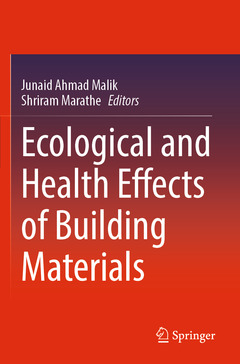Description
Ecological and Health Effects of Building Materials, 1st ed. 2022
Coordinators: Malik Junaid Ahmad, Marathe Shriram
Language: English
Subjects for Ecological and Health Effects of Building Materials:
Publication date: 08-2022
609 p. · 15.5x23.5 cm · Paperback
Publication date: 08-2021
609 p. · 15.5x23.5 cm · Hardback
Description
/li>Contents
/li>Biography
/li>Comment
/li>
This book deals with the present adverse effects of using precarious building materials on the ecology and human health. Also, the detailed discussions on the novel and greener construction materials and their utilization as an alternative to the conventional harmful existing methods and materials are also presented in the subsequent chapters. This book helps to fill the research gaps in the existing prior-art knowledge in the field of sustainable construction and green building materials and methods giving due importance to ecology and health, specifically to the fields of sustainable structural engineering, sustainable geotechnical engineering, sustainable road engineering, etc.
This book helps in achieving a sustainable environment through possible adoption of innovative and ecological construction practices. Hence, this book acts as a practical workbook, mainly for the academicians and practicing engineers who are willing to work toward the consecrated building industry.
It is a well-established fact that the constructions of the engineering structures consume more and more earth resources than any other human activities in the world. In addition, the construction-related activities will produce several million tons of greenhouse gases, toxic emissions, water pollutants, and solid wastes. This creates a huge impact on environment and causes severe health issues on humans and animals. It is thus important to create an eco-friendly construction environment which can satisfy the ecological and health requirements.
Preface
1. Potentially toxic construction materials: An Introduction
2. The main ecological health hazards from building materials
3. Atmospheric emissions from construction sector
4. PVC (The poison plastic), Chlorinated Polyethylene (CPE), Chlorinated Polyvinylchloride (CPVC), Chlorosulfonated Polyethylene (CSPE), Polychloroproprene Rubber (CR)- Chemistry, Applications and ecological impacts
5. Volatile Organic Compounds (VOC) emission and its adverse health effects from building sector
6. Heavy metal contaminations from construction materials
7. Nanoparticles in construction industry and their toxicity
8. Traditional and novel thermal insulation materials and their implications
9. Sulfo-Aluminate cement and magnesium phosphate cement in eco-conservation
10. Exposure to airborne concrete, stone, brick and granite dust
11. Carpets and textiles: Effect on indoor environment and health
12. Soil contaminations from the construction projects
13. Water pollution from construction industry
14. Construction sector, biodiversity and wildlife conservation
15. Embodied carbon in constructions and its ecological implications
16. Building Material Assessment System (BMAS) and its determination
17. Advances in Environmental impact assessment methods/tools in construction engineering
18. Special Concretes for Ecological Preservations.
19. Use of industrial waste materials in Civil Engineering Applications
20. Utilization of waste water for the construction projects
21. Use of Construction and Demolition wastes in Civil Engineering for Ecological preservation
22. Sustainable Techniques for building waste disposals
23. Ecological and sustainable Road constructions
24. Health impacts of thee Construction Workers
25. Sustainable Geotechnical practices in the Constructions
26. Sustainable infrastructural Development through Ecological ConservationsDr. Malik received B.Sc. (2008) Science from the University of Kashmir, Srinagar, J&K; M.Sc. (2010) in Zoology from Barkatullah University, Bhopal, Madhya Pradesh; and PhD (2015) in Zoology from the same university. He completed his B.Ed program in 2017 from the University of Kashmir, Srinagar, J&K. He started his career as Lecturer in School Education Department, Govt. of J&K for 2 years. Dr. Malik is now working as a Lecturer in Department of Zoology, Govt. Degree College, Bijbehara, Kashmir (J&K) and actively involved in teaching and research activities. He has more than 8 years of research experience. His areas of interest are ecology, soil macrofauna, wildlife biology, conservation biology etc. Dr. Malik has published more than 20 research papers in various national and international peer-reviewed journals. He has authored 4 books, 16 book chapters, edited 7 books, and more than 10 popular editorial articles. He is also serving as editor and reviewer of several journals with a reasonable repute. He has participated in several State, National, and International conferences, seminars, workshops, and symposia and more than 20 conference papers are to his credit. He is the life member of SBBS (Society for Bioinformatics and Biological Sciences) with membership id LMJ-243.
Dr. Shriram Marathe is serving as an Assistant Professor in the Department of Civil Engineering at NMAM Institute of Technology NITTE. He completed his Ph.D. degree at VTU Belagavi in the area of Alkali Activated Concrete Pavements. He accomplished his M.Tech (Transportation Engineering) from National Institute of Technology, Surathkal, Karnataka, and Master Facilitator Degree (MFLHRD) in Human Resources Development from CLHRD, Mangalore. His areas of research include Alkali-activated Concrete applications to pavements, Stabilization of Sub-grade soil, Road Safety, Pavement Material characterization, and Pavement Design. He has guided several projects for B.E. and M.Tech dissertat
Brings forth ecological and human health threats associated with building materials
Proposes ways to reduce ecological and health impacts in building materials
Examines the potential air and aquatic pollution from the construction sites/materials
Correlates the construction sector, biodiversity, and wildlife conservation




